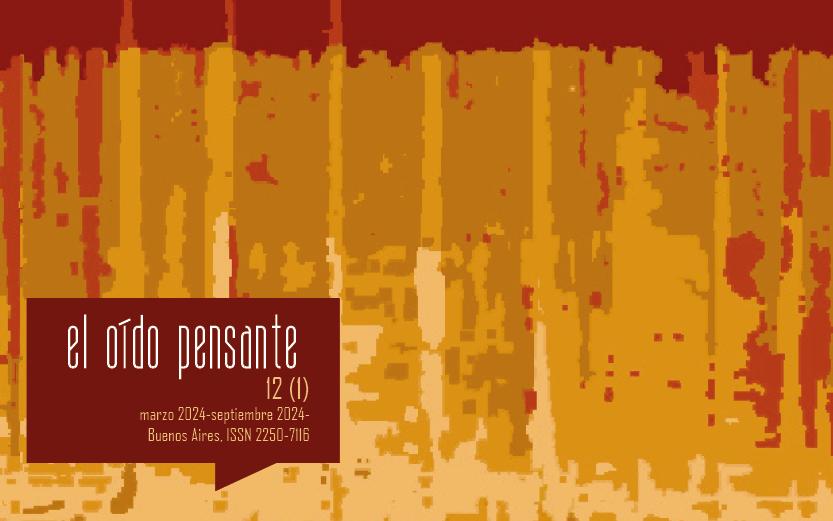Música moderna: The New Wave in the Spanish Context
Abstract
This research reflects on the new wave as a musical genre and its problems when it comes to locating it into the Spanish context through the particular case of la Movida and the Radio Futura group. Features such as pastiche, irony, or negotiations around the concept of modernity that appeared in the eighties are approached. The methodology used considers tools taken from cultural studies, popular music studies, as well as others borrowed from musicology, particularly for the analysis of some musical elements. At first, contradictions inside the new wave as a musical genre and its struggling relationship with postmodernity are addressed. Secondly, the example of Radio Futura is analysed as one of the groups that put the new wave into the Spanish popular music scenes of the eighties. Finally, through the song “Enamorado de la moda juvenil” features such as the new wave’s punk legacy or irony are analysed to think about how these elements work outside the British and American contexts.Downloads
References
Arenillas Meléndez, S. y Díaz González, D. (2019). Tino Casal y la modernización del pop español en los años ochenta. Anuario Musical, 74, 105-120.
Auserón, S. (1998). La imagen sonora: Notas para una lectura filosófica de la nueva música popular. Valencia: Episteme.
Bennett, A. y Peterson, R. A. (2004). Introducing Music Scenes. En Music Scenes: Local, Translocal, and Virtual (pp. 1-15). Nashville: Vanderbilt University press.
Bermúdez, S. (2009). Memoria y archivo: La Movida, Alaska y procesos de arqueología cultural. Arizona Journal of Hispanic Cultural Studies, 13, 171-181.
Cateforis, T. (2004). Performing the Avant-Garde Groove: Devo and The Whiteness of the New Wave. American Music, 22(4), 564-588.
Cateforis, T. (2011). Are we not New Wave?: Modern Pop at the Turn of the 1980s. Ann Arbor: University of Michigan Press.
Cateforis, T. (2014). “New Wave”. En Grove Music Online doi: https://doi.org/https://doi.org/10.1093/gmo/9781561592630.article.A2267342
Cohen, S. (1991). Rock culture in Liverpool: Popular music in the making. Oxford: Oxford University Press.
Covach, J. (2003). Pangs of History in Late 1970s New-Wave Rock. En A. F. Moore (ed.). Analyzing Popular Music (pp. 173-195). Cambridge: Cambridge University Press.
Fabbri, F. (1982). A Theory of Musical Genres: Two Applications. En D. Horn y P. Tagg (eds.). Popular Music Perspectives (pp. 52-81). Göteborg, London: IASPM.
Fellone, U. (2018). Genealogía y género musical: el caso del post-rock. En A. M. Botella Nicolás y R. Isusi Fagoaga (eds.). Músicas populares, sociedad y territorio: sinergias entre investigación y docencia (pp. 209-219). Valencia: Universidad de Valencia.
Fellone, U. (2022). El género musical en la actualidad: reflexiones ante un contexto digital y globalizado. El Oído Pensante, 10(1), 59-85.
Fornäs, J. (1995). The Future of Rock: Discourses that Struggle to Define a Genre. Popular Music, 14(1), 111.
Foster, H. (1983). Postmodernism: A Preface. En H. Foster (ed.). The Anti-aesthetic: Essays on Postmodern Culture (pp. ix-xvi). Seattle: Bay Press.
Fouce, H. (2006). El futuro ya está aquí: música pop y cambio cultural. Madrid: Velecío Editores.
Fouce, H. (2008). Emociones en lugar de soluciones música popular, intelectuales y cambio político en la España de la Transición. TRANS - Revista Transcultural de Música, 12.
Frith, S. (1996). Genre Rules. En Performing Rites: On the Value of Popular Music (pp. 75-95). Oxford: Oxford University Press.
García Peinazo, D. (2017). Rock andaluz: significación musical, identidades e ideología en la España del tardofranquismo y la transición (1969-1982). Madrid: SEdeM.
Gracyk, T. (1996). Rhythm and Noise: An Aesthetics of Rock. London: I. B. Tauris.
Grossberg, L. (1989). Putting the Pop Back into Postmodernism. Social Text, 21, 167-190.
Grossberg, L. (1992). Rock, Posmodernity and Authenticity. En We Gotta Get Out of this Place: Popular Conservatism and Postmodern Culture (pp. 201-239). London, New York: Routledge.
Holt, F. (2007). Genre in Popular Music. Chicago: Chicago Press.
Hutcheon, L. (1995). Irony’s Edge: The Theory and Politics of Irony. London: Routledge.
Iglesias, I. (2017). La modernidad elusiva: jazz, baile y política en la Guerra Civil española y el franquismo (1936-1968). Madrid: CSIC.
Iglesias, I. (2021). Pasados posibles de la música popular: narrativas históricas del jazz y del rock. El Oído Pensante, 9(1), 233-265.
Jameson, F. (1983). Postmodernism and Consumer Society. En The Anti-aesthetic: Essays in Postmodern Culture (pp. 111-125). Port Townsend: Bay Press.
Kronengold, C. (2008). Exchange Theories in Disco, New Wave, and Album-Oriented Rock. Criticism, 50(1), 43-82.
Laing, D. (1985). One Chord Wonders: Power and Meaning in Punk Rock. Oakland: PM Press.
Larson, S. (2001). `Resulta que posmodernidad equivale a pintarse el pelo de verde´, or getting over Spanish Postmodernism. Monographic Review/ Revista Monográfica, 17, 104-118.
Lechado García, J. M. (2005). La movida: una crónica de los 80. Madrid: Algaba.
Lenore, V. (2018). Espectros de la movida: porqué odiar los 80. Madrid: Akal.
Márquez, F. (2009 [1981]). Música moderna. Madrid: Libros Walden.
Moore, A. F. (2002 [1993]). Rock: The Primary Text. Farnham: Ashgate.
Moore, A. F. (2001). Conventions in Music-discourses: Style and Genre. Music and Letters, 82(3), 432-442.
Nichols, W. J. y Song, H. R. (Eds.). (2014). Toward a Cultural Archive of La Movida: Back to the Future. Cranbury: Fairleigh Dickinson University Press.
Pavlovic, T. (2003). Despotic Bodies and Transgressive Bodies: Spanish Culture from Francisco Franco to Jesús Franco. Albany: State University of New York Press.
Pedro, J. (2021). El blues en España: hibridación y diversidad cultural desde los orígenes al auge de la escena madrileña. Valencia: Tirant lo Blanch.
Pedro, J., Piquer Sanclemente, R. y Val Ripollés, F. del. (2018). Repensar las escenas musicales contemporáneas: genealogía, límites y aperturas. Etno: Cuadernos de etnomusicología, 12, 63-88.
Pérez Díaz, P. (2009). Música y situacionismo. De John Cage al «punk rock». Revista de Musicología, 32(2), 579-590.
Pérez, J. (2014). Queer Traces in the Soundtrack of la Movida. En W. J. Nichols y H. R. Song (eds.). Toward a Cultural Archive of la Movida (pp. 135-154). Fairleigh: Dickinson University Press.
Shank, B. (1994). Dissonant identities: The Rock ‘n’ Roll scene in Austin, Texas. Hanover: Wesleyan University Press.
Straw, W. (1991). Systems of Articulation Logics of Change: Communities and Scenes in Popular Music. Cultural Studies, 5(3), 361-375.
Straw, W. (2006). Scenes and Sensibilities. Compos, 6, 1-16.
Tango, C. (2006). La transición y su doble. El rock y Radio Futura. Madrid: Biblioteca Nueva.
Turner, K. L. (2015). Introduction: The Sound of Irony/The Irony of Sound. En K. L. Turner (ed.). This is the Sound of Irony: Music, Politics and Popular Culture (pp. 1-16). Farnham: Ashgate.
Uribe, M. (2003). Polvo, niebla, viento y rock: cuatro décadas de música popular en Aragón. Zaragoza: Ibercaja.
Val, F. del. (2009). ¿Movida promovida? El uso político de la cultura popular en la Transición. VII Congreso Internacional ULEPICC: Políticas de cultura y comunicación, 924-940.
Val, F. del. (2017). Rockeros insurgentes, modernos complacientes: un análisis sociológico del rock en la Transición (1975-1985). Madrid: SGAE.























